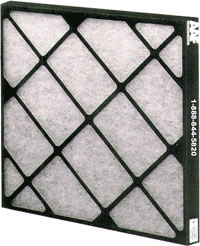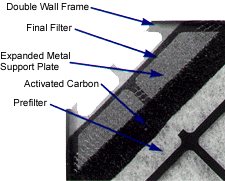
| WHITE FILTER INC. | |
| TEXAS OLDEST COMPLETE FILTER SALES & SERVICE |
 |
|
| P.O. Box 940034 | Plano, Texas 75094 | ||
| 214.340.2337 Office | sales@whitefilter.com | ||
| 972.398.0696 Fax | www.whitefilter.com | ||
| Home | Pleated Filters | Bag Filters | Auto Rolls | Panel Links | Poly Cubes | Paint Booth | Odor Control | Frames & Media | Grease Filters | Services | Feed back |
AmAir C The effectiveness of any odor control filter corresponds to the density (weight per square foot) of activated carbon contained in the product. AmAir C filters are more effective than other odor control filters because they contain more carbon - up to 50 times more. Greater carbon density solves your odor problems by removing odor concentrations and providing protection over a longer period of time. The true test of a carbon filter is how long it will continue to remove objectionable odors. AmAir C filters deliver fresh air longer. No messy trays to refill or exchange. Simply install the filters as you would standard air filters and dispose of them when they are no longer effective.
|
 Easy to install and directly interchangeable with standard air filters. |
Effective on wide variety
of odors found in: • Commercial buildings • Shopping Centers • Hospitals • Restaurants • Health Clubs • Homes • Schools • Hotels/Motels
|
• Prefilter • Activated Carbon - Guide for Vapors,
Gases and Fumes removed by Activated Carbon. • Final Filter |
 Unique Three-Stage
Panel Filter Construction |
| Totally Unitized Construction offers
Superior Strength Panel style filters are contained in a frame constructed of high wet strength, moisture resistant beverage board. Two mating die cut boxes are bonded together forming a double wall around the entire filter. The three stage media pad is bonded to the inside of the frame on all four edges to prevent leakage and increase rigidity. On 2" thick panel filters, an expanded metal plate is inserted to provide additional support. Each panel filter or pad is individually sealed in a poly bag to prevent adsorption of random odors prior to installation. AmAir C panel filters are available with three levels of carbon loading to solve various degrees of odor problems. The higher the carbon density (weight of carbon per square foot of filter face area), the more gas molecules the filter can adsorb. This enables the filter to adsorb higher concentrations of odor and continue to provide freshened air over a longer period of time. |
| Performance Data | Initial Resistance (In. W.G.) 300FPM |
Initial Resistance (In. W.G.) 500FPM |
Rated Average Arrestance @ 500 FPM |
Recommended Final Resistance (In. W.G.) |
Carbon Density (Gms./Ft.2) |
| AmAir C-1 (1" depth) | .18" | .42" | 60-65% | 1.0" | 100 |
| AmAir C-2 ( 2" depth) | .22" | .51" | 70-75% | 1.2" | 150 |
| AmAir C-3 ( 2" depth) | .31" | .75" | 75-80% | 1.2" | 300 |
| Nominal Size Inches (W x H x D) |
Actual Size Inches (W x H x D) |
Rated Air Flow Capacity (CFM) |
| AmAir C-1 | ||
| 12 x 24 x 1 | 11 7/16 x 23 7/16 x 7/8 | 1,000 |
| 16 x 20 x 1 | 15 7/16 x 19 7/16 x 7/8 | 1,100 |
| 16 x 25 x 1 | 15 7/16 x 24 7/16 x 7/8 | 1,400 |
| 20 x 20 x 1 | 19 7/16 x 19 7/16 x 7/8 | 1,400 |
| 20 x 25 x 1 | 19 7/16 x 24 7/16 x 7/8 | 1,750 |
| 24 x 24 x 1 | 23 7/16 x 23 7/16 x 7/8 | 2,000 |
| AmAir C-2 | ||
| 12 x 24 x 2 | 11 7/16 x 23 7/16 x 1¾ | 1,000 |
| 16 x 20 x 2 | 15 7/16 x 19 7/16 x 1¾ | 1,100 |
| 16 x 25 x 2 | 15 7/16 x 24 7/16 x 1¾ | 1,400 |
| 18 x 24 x 2 | 17 7/16 x 23 7/16 x 1¾ | 1,500 |
| 20 x 20 x 2 | 19 7/16 x 19 7/16 x 1¾ | 1,400 |
| 20 x 24 x 2 | 19 7/16 x 23 7/16 x 1¾ | 1,650 |
| 20 x 25 x 2 | 19 7/16 x 24 7/16 x 1¾ | 1,750 |
| 24 x 24 x 2 | 23 7/16 x 23 7/16 x 1¾ | 2,000 |
| AmAir C-3 | ||
| 12 x 24 x 2 | 11 7/16 x 23 7/16 x 1¾ | 1,000 |
| 16 x 20 x 2 | 15 7/16 x 19 7/16 x 1¾ | 1,100 |
| 16 x 25 x 2 | 15 7/16 x 24 7/16 x 1¾ | 1,400 |
| 18 x 24 x 2 | 17 7/16 x 23 7/16 x 1¾ | 1,500 |
| 20 x 20 x 2 | 19 7/16 x 19 7/16 x 1¾ | 1,400 |
| 20 x 24 x 2 | 19 7/16 x 23 7/16 x 1¾ | 1,650 |
| 20 x 25 x 2 | 19 7/16 x 24 7/16 x 1¾ | 1,750 |
| 24 x 24 x 2 | 23 7/16 x 23 7/16 x 1¾ | 2,000 |
Guide for Vapors, Gases and Fumes removed by Activated Carbon.
The numbers given represent typical or average conditions and might vary in specific instances. The values in the table have been assembled from many sources including laboratory tests and field experience.
The capacity index has the following meaning:
4. High capacity
for all materials in this category. One pound takes up about 20% to 50% of its own weight
average about 1/3 (33 1/3%). This category includes most of the odor causing substances.
3.
Satisfactory capacity for all items in this category. These constitute good applications
but the capacity is not as high as for category 4. Absorbs about 10% to 25% of its
weight-average about 1/6 (16.7%).
2. Includes
substances which are not highly adsorbed but which might be taken up sufficiently to give
good service under the particular conditions of operation. These require individual
checking.
1. Adsorption
capacity is low for these materials. Activated carbon cannot be satisfactorily used to
remove them under ordinary circumstances.
* Straight activated carbon does not have much capacity for some reactive gases, such as ammonia, formaldehyde, etc. In some cases where the gas is chemically reactive, appropriate impregnated activated carbon can be recommended. Those odorants marked below with an asterisk fall into this category.
| Substance
* Acetaldehyde |
Index 2 |
Pricing available on request.
For requests, visit our Feedback page.
Send mail to Sales@whitefilter.com
with questions or comments about this web site.